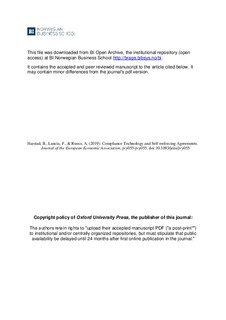Compliance Technology and Self-enforcing Agreements
| dc.contributor.author | Russo, Alessia | |
| dc.contributor.author | Harstad, Bård Gjul | |
| dc.contributor.author | Lancia, Francesco | |
| dc.date.accessioned | 2019-01-21T08:51:12Z | |
| dc.date.available | 2019-01-21T08:51:12Z | |
| dc.date.created | 2019-01-07T09:42:03Z | |
| dc.date.issued | 2019 | |
| dc.identifier.citation | Journal of the European Economic Association. 2019 | nb_NO |
| dc.identifier.issn | 1542-4766 | |
| dc.identifier.uri | http://hdl.handle.net/11250/2581388 | |
| dc.description.abstract | This paper analyzes a game in which countries repeatedly make emission and technology investment decisions. We derive the best equilibrium, that is, the Pareto-optimal subgame-perfect equilibrium, when countries are insufficiently patient for folk theorems to be relevant. Relative to the first best, the best equilibrium requires countries to overinvest in technologies that are green, that is, strategic substitutes for polluting, but to underinvest in adaptation and brown technologies, that is, strategic complements to polluting. Technological transfers and spillovers might discourage investments but can be necessary to motivate compliance with emissions when countries are heterogeneous | nb_NO |
| dc.language.iso | eng | nb_NO |
| dc.publisher | Oxford | nb_NO |
| dc.title | Compliance Technology and Self-enforcing Agreements | nb_NO |
| dc.type | Journal article | nb_NO |
| dc.type | Peer reviewed | nb_NO |
| dc.description.version | acceptedVersion | nb_NO |
| dc.source.volume | 17 | nb_NO |
| dc.source.journal | Journal of the European Economic Association | nb_NO |
| dc.source.issue | 1 | nb_NO |
| dc.identifier.cristin | 1651208 | |
| cristin.unitcode | 158,3,0,0 | |
| cristin.unitname | Institutt for samfunnsøkonomi | |
| cristin.ispublished | false | |
| cristin.fulltext | postprint | |
| cristin.qualitycode | 2 |
Tilhørende fil(er)
Denne innførselen finnes i følgende samling(er)
-
Publikasjoner fra CRIStin - BI [1015]
-
Scientific articles [2173]
